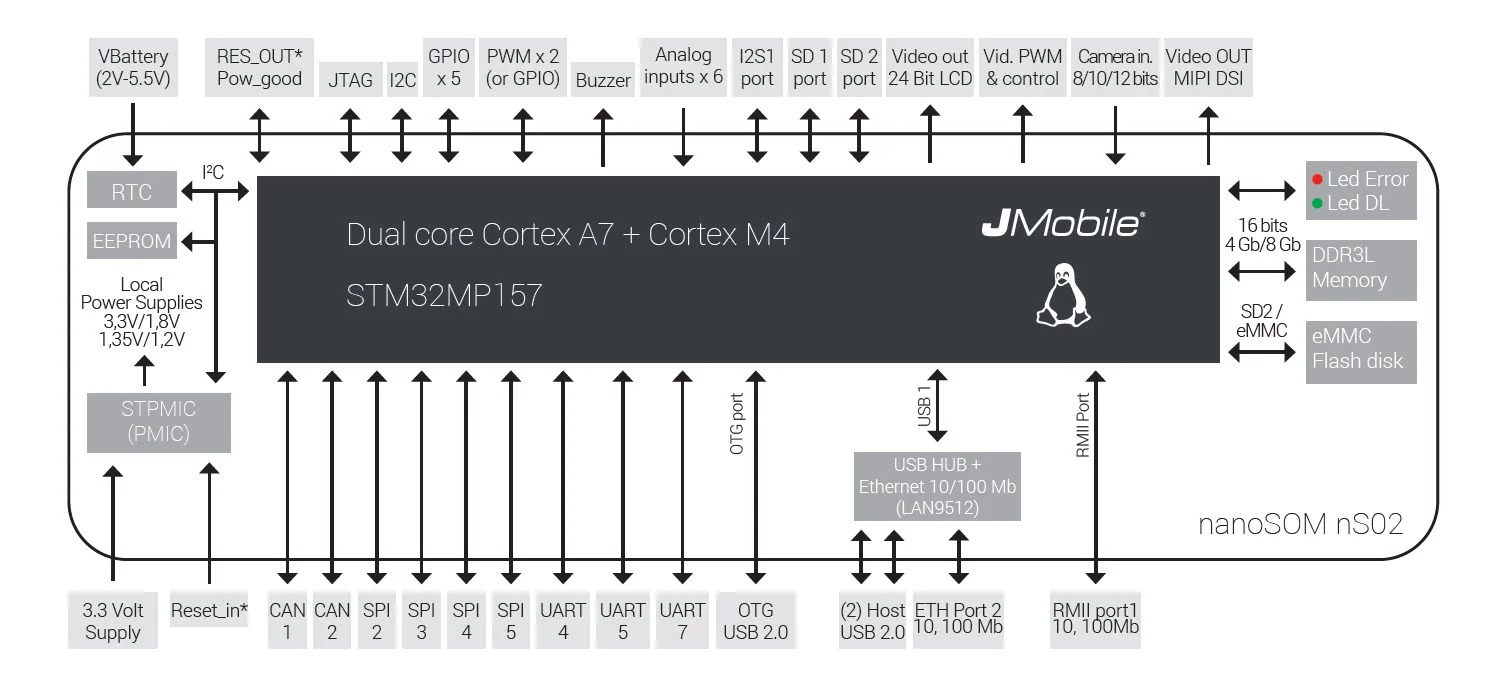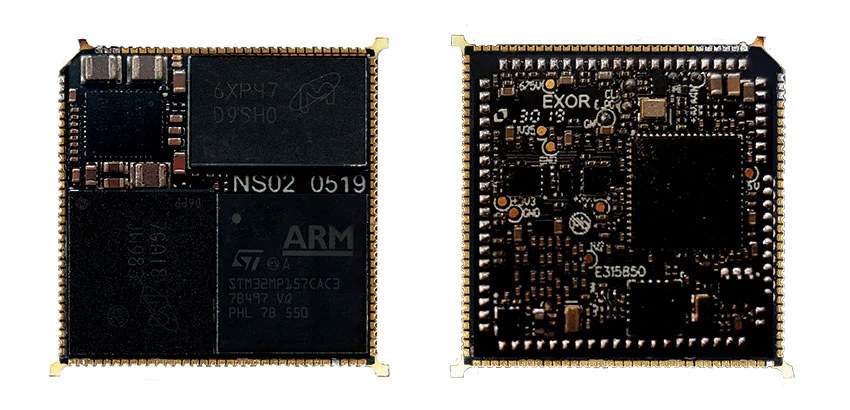Arrow Electronics and Exor Embedded have announced the nanoSOM nS02 system-on-module based on the 800MHz version of STMicro STM32MP1 microprocessor unveiled last February.
The 25.4 x 25.4mm module is designed for IoT edge applications such as smart IoT controllers and gateways, cloud edge interfaces, and building automation. A supporting development kit can also be provided by Arrow Electronics.
- SoC -STMicro STM32MP157 dual-core Cortex-A7 processor @ 800MHz with 3D GPU
- System Memory – Up to 1GB DDR3L
- Storage – Up to 32GB eMMC flash, 4KB EEPROM
- USB & Ethernet Hub – Microchip LAN9512 controller
- 131x solder pads with
- Storage – 2x SD
- Video Output – 24-bit RGB LCD parallel or 2-lane MIPI DSI
- Camera Input – 8,10,12-bit video input
- Audio – 1x I2S channel
- Networking – 2x 10/100M Ethernet (one native, one via USB hub)
- USB – 2x USB 2.0 host, 1x USB OTG
- 4x SPI, 1x I2C, 2x CAN, 3x UART
- Analog Inputs
- GPIOs with interrupt capability
- Reserved Pins for Power-Fail, Power Good, Reset IN, Reset Out functions.
- HW Security – Secure boot, Trust Zone IPs
- Misc – RTC, watchdog, voltage monitor
- Power Supply – 3.3V; VBB for RTC backup; STPMIC power management IC
- Dimensions – 25.4 x 25.4 x 3 mm
- Temperature Range – Commercial: 0°C to 70°C; industrial: -40°C to +85°C

Exor provides a Linux RT board support package (BSP) or Android BSP for the module which also fully supports the company’s X Platform including Exor Embedded Open HMI software, Corvina Cloud IIoT platform, and IEC61131 CODESYS or Exor xPLC runtime.
The OpenHMI software platform enables the design of SVG and HTML5 based graphical user interfaces, and device connectivity with over 200 communication protocols. The company also says MQTT and OPC-UA interfaces are available together with cloud connectivity for telemetry and remote assistance using OpenVPN software.
NanoSOM nS02 system-on-module is available now in several standard configurations with 256MB or 512MB DDR RAM with 4GB eMMC flash disk, or 1GB DDR RAM with 8GB eMMC flash disk. The lifecycle of the module is guaranteed to be at least 10 years from the time of product launch. You’ll find additional details, as well as documents such as datasheet and user manual, on the product page. What about the development kit mentioned in the introduction? It doesn’t show up anywhere, and Arrow website currently only sells Exor devkits for the earlier NanoSOM NS01 based on NXP i.MX 6UltraLite processor.

Jean-Luc started CNX Software in 2010 as a part-time endeavor, before quitting his job as a software engineering manager, and starting to write daily news, and reviews full time later in 2011.
Support CNX Software! Donate via cryptocurrencies, become a Patron on Patreon, or purchase goods on Amazon or Aliexpress





Great to see STM32MP1 is taking steam and modules are becoming available.
Only grain of salt is the second ethernet via USB, I personally would have preferred a managed ethernet switch instead, to add a second port, I suppose those must also be available in industrial temperature range.
I think these will just be too expensive to go really mainstream and be used in something that isn’t a niche industrial widget.
I doubt so, as every 25$ WLAN router has one built in, maybe not industrial grade but…
$25 wlan router is going to have the cheapest chip possible which will probably be MIPS based.. probably never based on a chip from a company you know.
Like Qualcomm, Mediatek, Infineon, Realtek, Broadcom and for sure many more.
And you are right, in modern low-cost designs the switch is part of the SOC, but when a router still cost 50$ the switch was a separate piece of silicon.
>but when a router still cost 50$ the switch >was a separate piece of silicon. mm I had the impression the low end router market (non-rack stuff) had been using single chip solutions with a hub, wifi and the processing in a single SoC since the days of the WRT54G. Maybe it’s different now that gigabit ethernet is standard. I don’t think I’ve see a SoC with a gigabit phy integrated even for a single port. But really I still think this will be too expensive for anything except industrial stuff. The cheap e-waste SoCs are really cheap. i.e. I… Read more »
Sorry for totally messing up the reply.. too late to edit now.
Still got what you meant 🙂
I don’t know any prices but i doubt such a switch on an rmii costs much more than that usb hub thing.
Wrt54g had an admtek or later a bcm switch: https://deviwiki.com/wiki/Linksys_WRT54G_series
Also a slightly newer and higher end router with atheros switch: https://deviwiki.com/wiki/AVM_FRITZ!Box_Fon_WLAN_7390
> I don’t think I’ve see a SoC with a gigabit phy integrated even for a single port.
The only one I’m aware of is the MT7621A that runs in my edgerouter-x. Devices made around it are particularly cheap and have up to 5 GigE ports thanks to this! Example here: 5 GigE ports for 53 EUR: https://fr.aliexpress.com/item/32959995716.html
It’s the cheapest GigE-capable family of devices I’ve found to date.
In fact there’s an exception to this, the AR9331 found in many cheap devices. It’s usually sold with 2 ports attached but IIRC the integrated switch supports up to 5 ports. Sadly never mainline, but well supported by OpenWRT under ath79 family.